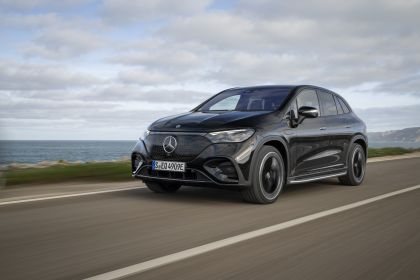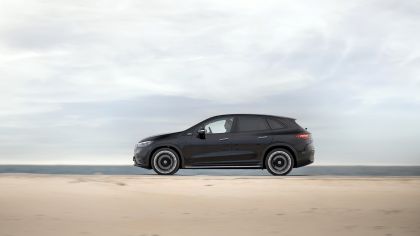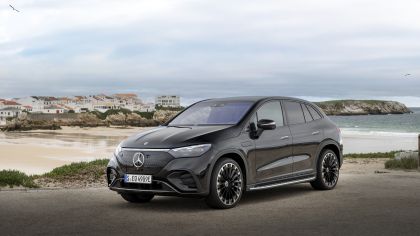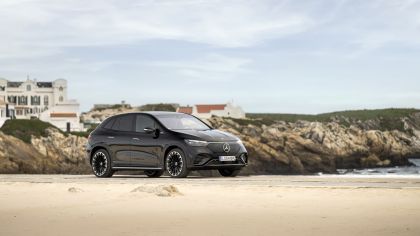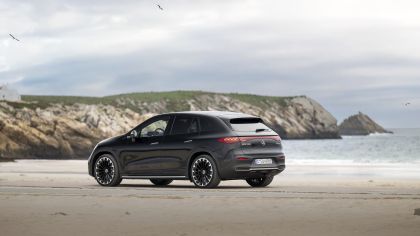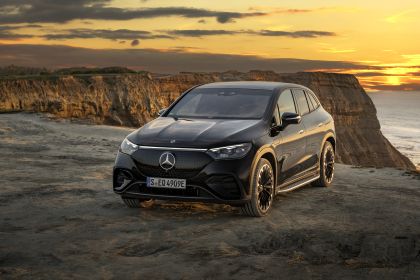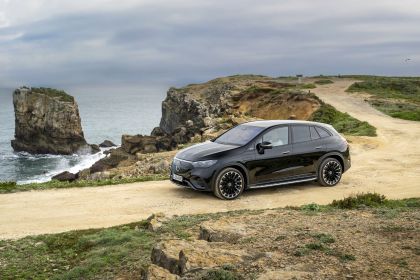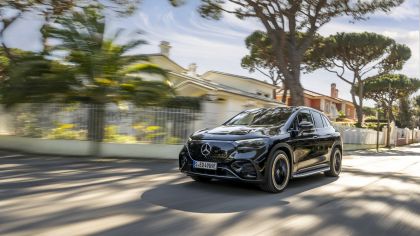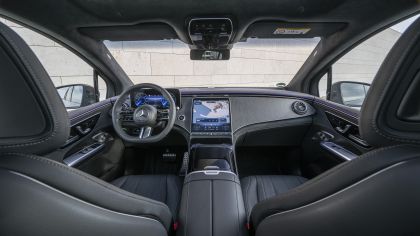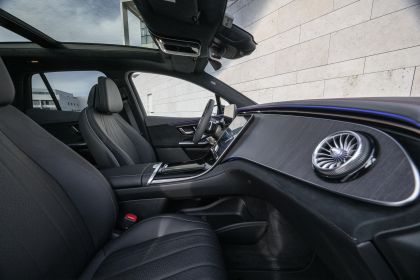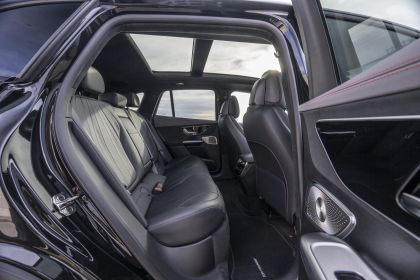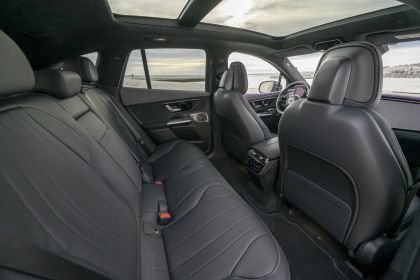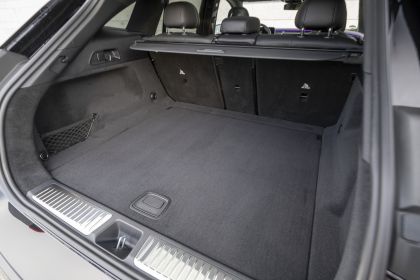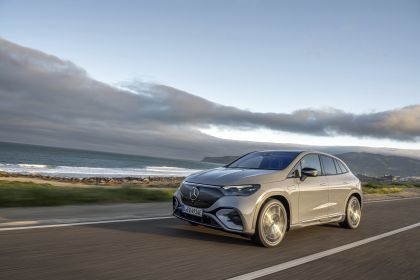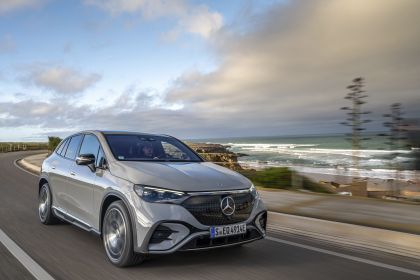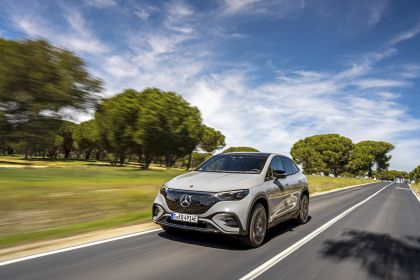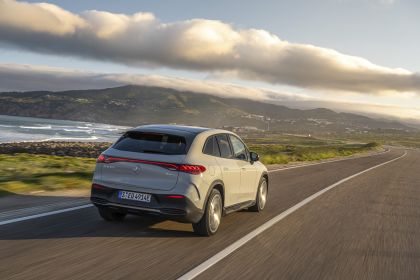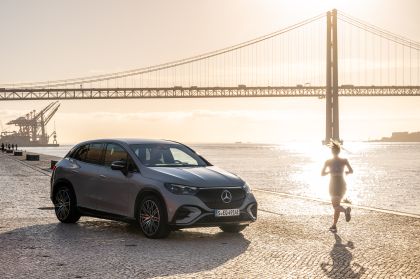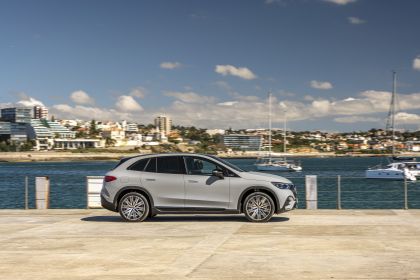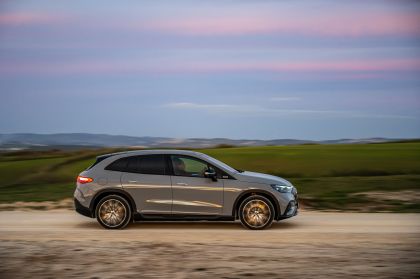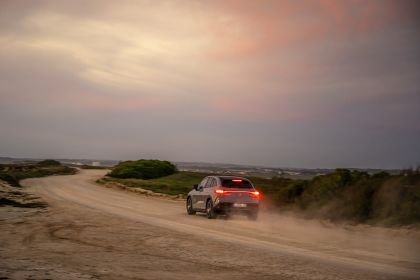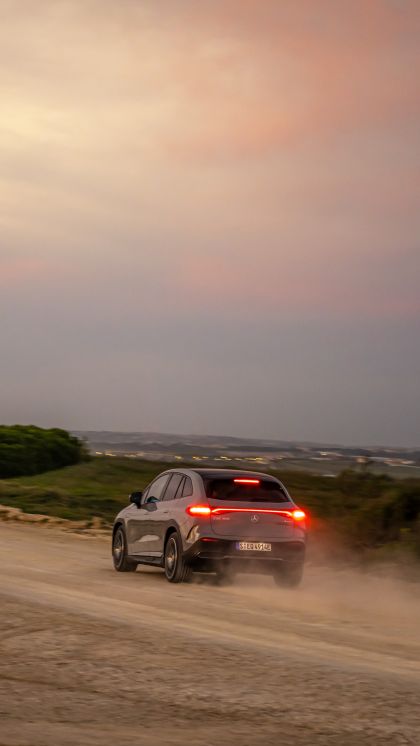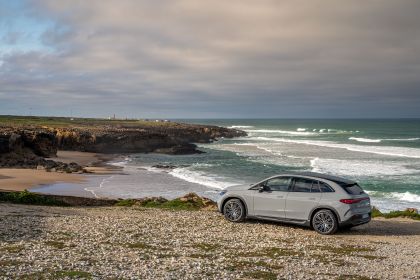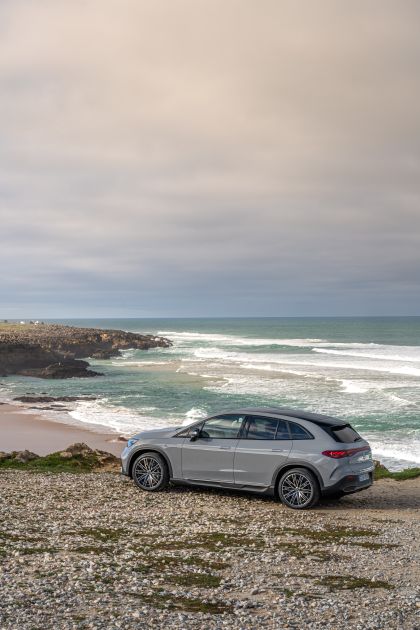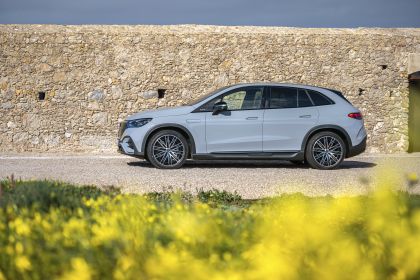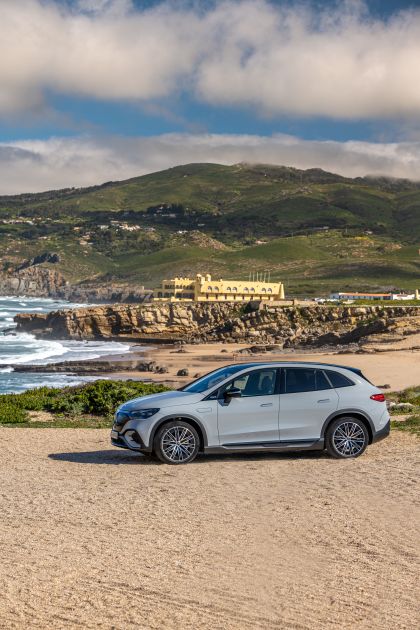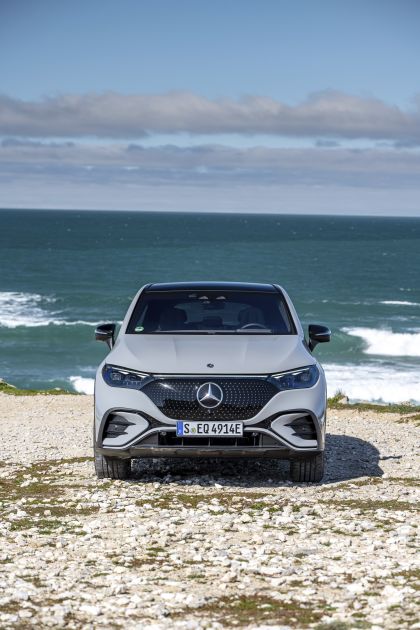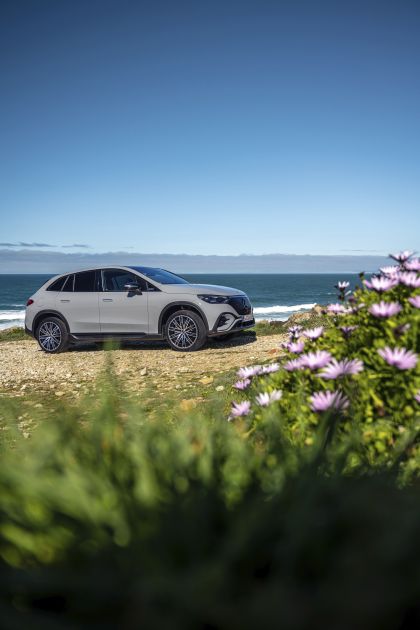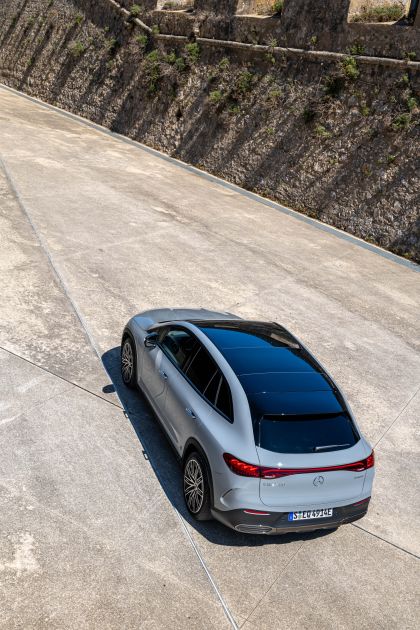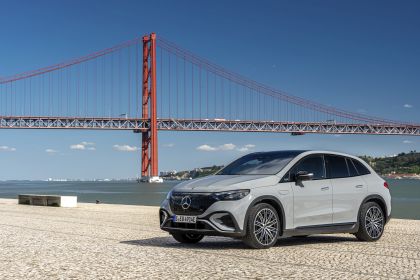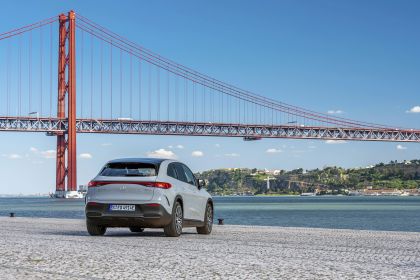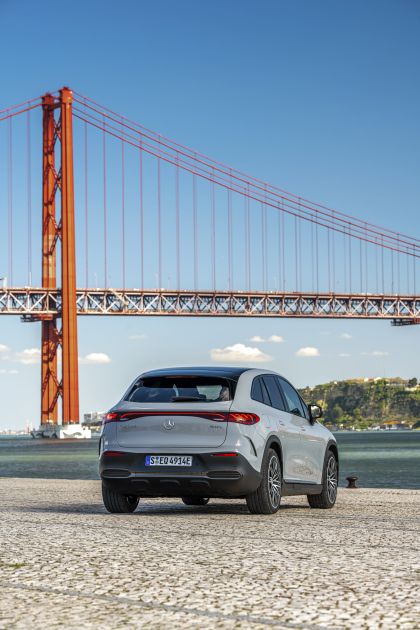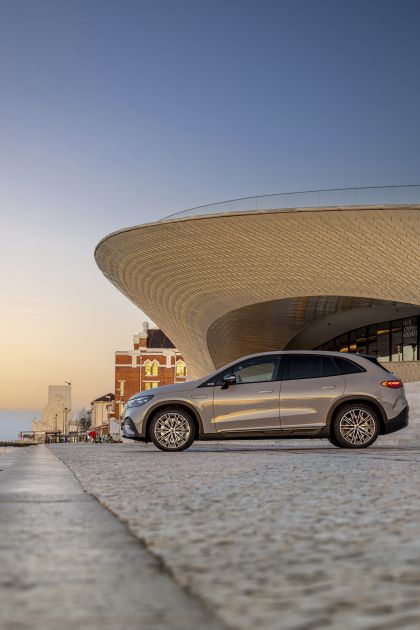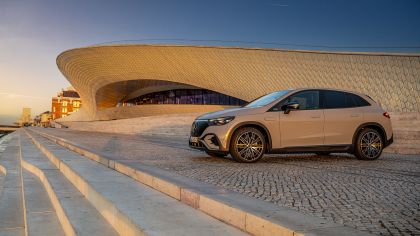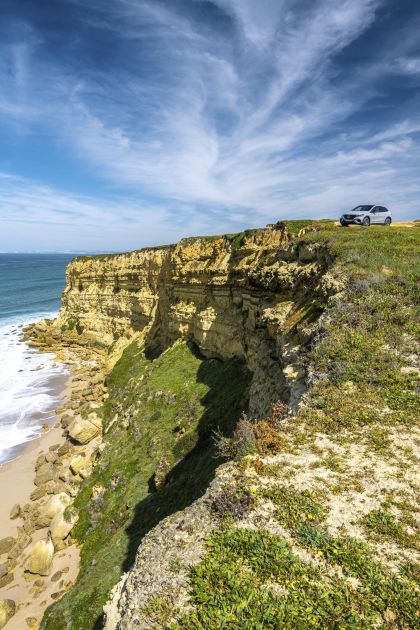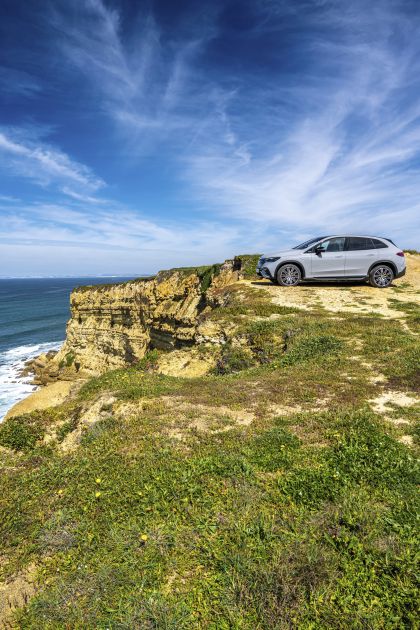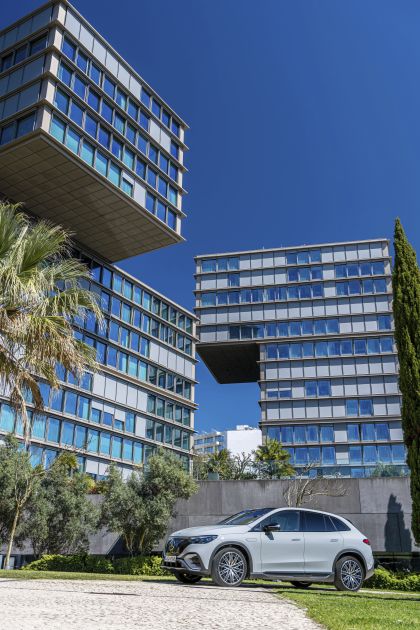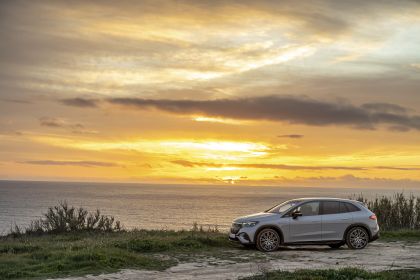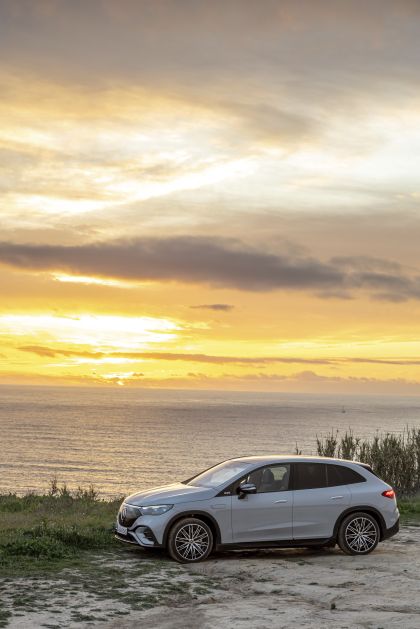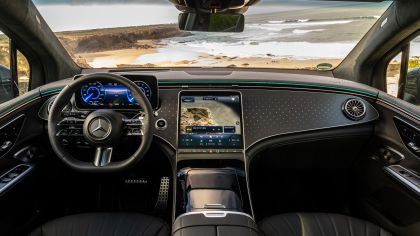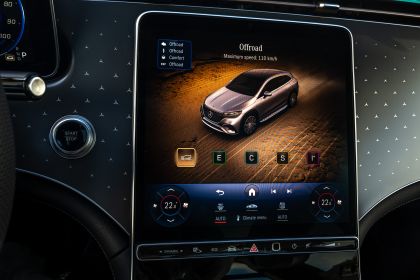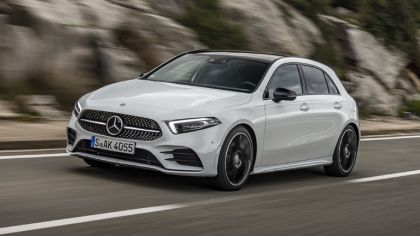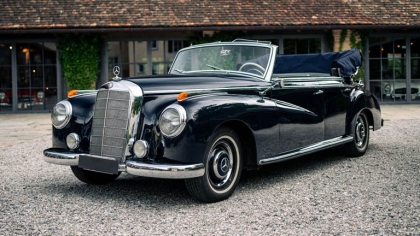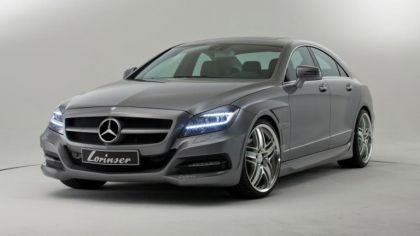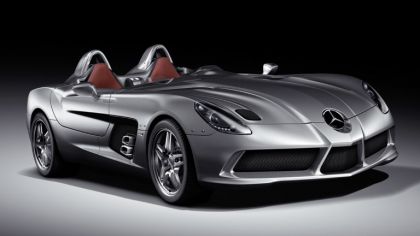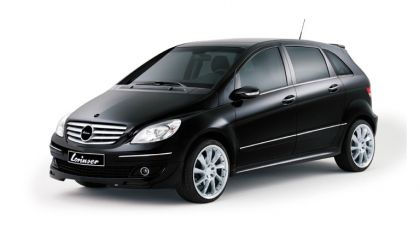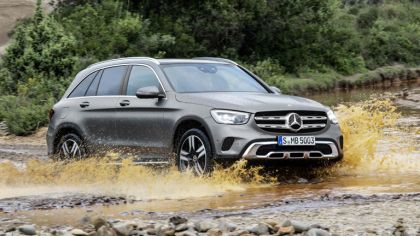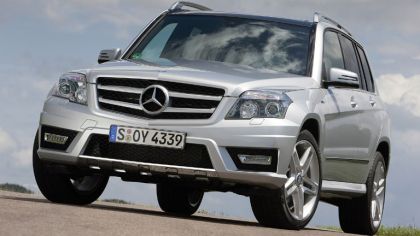The EQE SUV is the multi-purpose variant of the EQE executive saloon. Like the latter, it is available with the essential innovations of the EQS and at the same time is more dynamic than the EQS SUV. The EQE SUV is one of the most spacious representatives of its class. Yet it is more compact than the EQE Saloon and, at 3030 millimetres, has a wheelbase that is nine centimetres shorter. The external dimensions are 4863/1940/1686 millimetres (length/width/height). As the fourth model after the two EQS and EQE Saloons as well as the EQS SUV, the EQE SUV uses the new all-electric platform.
Up to 590 kilometres range
The modular drive concept enables the EQE SUV to offer a wide range of maximum total drive outputs from 215 to 300 kW. Depending on the vehicle equipment and configuration, the European vehicles can achieve WLTP ranges of up to 590 kilometres. In the EQE SUV, the lithium-ion battery consists of ten modules. In certain cases the innovative battery management software, which was developed in-house, can be updated over-the-air (OTA).
Extensive range of driving assistance systems
The current generation of driving assistance systems includes numerous functions that support the driver. The general standard equipment of the EQE SUV includes ATTENTION ASSIST, Active Brake Assist, Active Lane Keeping Assist, Parking Package with reversing camera and Speed Limit Assist. The status and activity of the systems are shown in a full-screen view in the assistance display in the driver's display. Further options are available in the Assistance Package and also the Driving Assistance Plus Package.
Particularly manoeuvrable and agile
The chassis of the new EQE SUV comprises a four-link suspension at the front and an independent multi-link suspension at the rear. Due to the comparatively short wheelbase of 3030 millimetres and the corresponding suspension tuning, it feels particularly agile and manoeuvrable even with the basic set-up. The AIRMATIC air suspension with ADS+ continuously adjustable damping is available as an optional extra. To increase ground clearance, the vehicle level can be raised by up to 30 millimetres. In addition to the DYNAMIC SELECT programs of ECO, COMFORT, SPORT and INDIVIDUAL, the EQE SUV models with 4MATIC also boast the OFFROAD program for off-road driving. A rear axle steering system with a maximum steering angle of 10 degrees is available as an option.
Always up to date
The EQE SUV offers the possibility of activating additional vehicle functions via over-the-air technology (OTA) in a number of functional areas. This means that after purchase and having chosen the original new car configuration, some of the EQE SUV's equipment can be individually customised. The OTA functions are available in the Mercedes me Store, and the range will be successively expanded.
MBUX Hyperscreen on request
With adaptive software, the MBUX display and operating system makes personalised suggestions for numerous infotainment, comfort and vehicle functions. A highlight of the interior is the optional MBUX Hyperscreen. With the zero-layer design, the user does not have to scroll through submenus or give voice commands. Situational and contextual applications are offered at the top level in the field of view. With the MBUX Hyperscreen (optional extra), three displays merge almost seamlessly into one another to create a screen band over 141 centimetres wide. The front passenger in the EQE SUV has the option of a 12.3-inch OLED display with its own user interface. The system uses an intelligent, camera-based blocking logic that recognises if the driver is looking toward the front passenger display. If this is the case, the system automatically dims the dynamic content for security reasons (see separate chapter).
Clever route planning
When it comes to Navigation with Electric Intelligence, the name says it all. For on the basis of numerous factors it plans the fastest and most convenient route including charging stops. It also reacts dynamically to traffic jams or a change in driving style, for example. Navigation with Electric Intelligence is clever; it calculates the estimated charging costs per charging stop. Furthermore, the customer can edit the planned routes individually. They can edit the planned routes individually by adding in preferred charging stations along the route or excluding proposed charging stations.
Heat pump as standard
The EQE SUV features a sophisticated thermal architecture with a heat pump as standard. This makes the system work very efficiently: the waste heat from the electric drive (inverter and electric motor) and also the high-voltage battery can be used to heat the interior. This reduces drastically the draw on battery power for the heating system, thus increasing the range. Another pleasant and efficient function is pre-entry climate control. The THERMATIC automatic climate control system with two climate zones is fitted as standard, while the THERMOTRONIC with four zones is available as an option.
New sound experience
"Serene Breeze" is the name of the new, fourth soundscape that makes its debut in the EQE SUV. It offers a relaxed and natural sound. With the holistic sound staging, the paradigm shift from combustion engine to electric car becomes audible for the occupants in the Mercedes-EQ models. A variety of soundscapes allows for an individual acoustic set-up. An optional interior driving sound is available. This adjusts adaptively to the driving style.
Tailor-made charging rates
Since June 2022, Mercedes me Charge has been offering three new charging tariffs in Europe that are tailored to individual driving performance. Mercedes me Charge S for occasional chargers, Mercedes me Charge M for normal chargers and Mercedes me Charge L for frequent chargers. With the introduction of the new, transparent tariff system, customers have access in part to fixed prices that apply regardless of the operator. With the Plug & Charge function, the EQE SUV can also be conveniently charged.
A host of high-tech features
DIGITAL LIGHT headlamp technology (special equipment) makes innovative functions possible, such as the projection of auxiliary markings or warning symbols onto the road. Another equipment highlight is ENERGIZING AIR CONTROL Plus. A HEPA (High Efficiency Particulate Air) filter cleans the incoming outside air at its very high filtration level. ENERGIZING COMFORT links together various comfort systems in the vehicle. The individual ENERGIZING COMFORT programmes enable a special feel-good programme depending on the mood or needs of the customer. This enhances physical comfort and performance while driving and during a break. The Dolby Atmos sound format takes the audio experience in the EQE SUV to a new level.
Distinctive purpose design
The proportions of the EQE SUV combine function and aesthetics with the sporty character of the SUV. The new model, with its unmistakable purpose design, marks a turning point in its class. The overhangs and the front-end assembly have been kept compact. The wheels in sizes from 19 to 22 inches are positioned flush with the outer edge of the body and lend a commanding stance.
A great deal of aerodynamic fine tuning
The EQE SUV shares some aerodynamic measures with its model brothers. The underbody with its numerous aerodynamic details plays a central role in a very good Cd value from 0.25, which was achieved despite the large load volume and short rear overhang. But the dimensional concept with the flat windscreen, sweeping roof line and indents were also important factors.
MBUX Hyperscreen and leather-free equipment available
The EQE SUV is based on the large electric platform from Mercedes-EQ. On top of this it boasts an interior that has been consistently digitalised. The optionally available MBUX Hyperscreen implements this vision to impressive effect. The standard Electric Art interior does not make use of any leather at all.
High level of passive safety
The principles of Integral Safety apply regardless of the type of drive system. Like all other Mercedes-Benz models, the EQS SUV therefore has a rigid passenger compartment, special deformation zones and state-of- the-art restraint systems. The European version of the EQE SUV can detect whether the rear seats are actually occupied. If a passenger in the rear is not wearing a seat belt, the driver receives a specific warning. The so- called occupant presence reminder can indicate children who may have been overlooked in the rear of the vehicle. In vehicles for Europe, Australia, New Zealand, USA and Canada, this system is on board as standard.
CO2-neutral production as part of the eco-balance
Production of the EQE SUV will start at the Mercedes-Benz plant in Tuscaloosa, Alabama (USA) in December. The battery factory in nearby Bibb County supplies the batteries for this model as well as for the EQS SUV. Since this year, all of Mercedes-Benz's own passenger car and van plants worldwide have achieved CO2- neutral production as part of their eco-balance - including the two Mercedes-Benz plants in Alabama.
The new EQE SUV: the electric drive
The modular drive concept enables the EQE SUV to offer a wide range of maximum total outputs. Subject to final certification, Mercedes-Benz expects these to be in a similar range to the data for the EQE sedans. Depending on the vehicle equipment and configuration, WLTP ranges of more than 550 kilometres (342 miles) can be expected for European vehicles (with the exception of AMG models).
All EQE SUVs have an electric drivetrain (eATS) on the rear axle. The versions with 4MATIC also have an eATS on the front axle. In the 4MATIC models, the Torque Shift function ensures intelligent, continuously variable distribution of drive torque between the rear and front electric motors and thus the use of the most efficient eATS in each case. The modular drive concept enables high overall performance and a long range.
To further increase the range, the electric motor at the front axle can be completely decoupled. This step is undertaken by what is known as the Disconnect Unit (DCU). The intelligent disconnection system works complete automatically depending on the driving situation and the required output. At low loads, the DCU switches into 4x2 driving mode, and both the electric motor and the relevant transmission at the front axle cease operation. This ensures that the drag losses otherwise normally experienced are largely eliminated.
The electric motors on the front and rear axles are permanently excited synchronous motors (PSM). On a PSM, the rotor of the AC motor is fitted with permanent magnets and therefore does not need to be supplied with power. The magnets - and thus the rotor - follow the rotating alternating current field in the stator windings. In the EQE SUV, Mercedes-Benz uses a pull-in winding for a particularly strong magnetic field. The motor is referred to as synchronous because the rotor turns at the same rate as the magnetic field of the stator. The frequency is adjusted in the power electronics inverters to the speed requirements of the driver. The advantages of this design include high power density, high efficiency and high power constancy. The motor on the rear axle is very powerful due to the six-phase design: it has two windings with three phases each.
Cooling: sophisticated thermal concept for high load capacity
Consistently high performance and multiple accelerations without a drop in power characterize the drive philosophy of the EQE SUV. This includes a sophisticated thermal concept with some special features. What is known as a water lance in the shaft of the rotor cools it from the inside. Other cooling elements in the cooling circuit are fins on the stator, a needle-shaped pin-fin structure on the inverter and a transmission oil cooler. This also brings more efficiency during cold driving, because the heat exchanger then serves to heat the transmission oil and thus reduces friction in the transmission.
Intelligent energy recovery: one-pedal driving to a standstill
The EQE SUV offers several variants of energy recovery by means of recuperation. In this process, the high-voltage battery is charged by converting the mechanical rotary motion into electrical energy during overrun or braking mode. The driver can manually select the deceleration in overrun mode in three stages (D+, D, D-) as well as the coasting function via shift paddles behind the steering wheel. Also available: DAuto.
ECO Assist also offers situation-optimized recuperation; deceleration is so strong or weak that it ultimately results in the most efficient driving style. Recuperative deceleration is also used as far as possible for vehicles detected ahead until they come to a standstill, for example at traffic lights. The driver does not need to press the brake pedal for this; literally one-pedal driving.
Noise and vibration comfort: comprehensive measures
Even the design of the electric drivetrains (eATS) takes into account noise and vibration comfort, or NVH for short (Noise, Vibration, Harshness). The magnets are arranged inside the rotors in an NVH-optimized way (known as 'lamination'). This also reduces the use of rare earths. The shape of the winding, the stator tilt, also causes less vibration, especially at low speeds. The coils in the stator are at an angle in relation to the permanent magnets of the rotor. Otherwise, what is known as cogging torque could occur, they would lead to slight but unpleasant vibrations when driving very slowly.
In addition, the eATS have a special foam mat all around as an NVH cover. The inverter cover has a sandwich construction of three metal and plastic layers. The eATS are doubly decoupled from the body via elastomer bearings: at the front axle opposite a supporting frame and this against the body, at the rear axle with a subframe.
Highly effective spring/mass components provide continuous sound insulation from the cross member under the windshield to the floor of the load compartment. Acoustic foams are inserted into many members during construction of the bodyshell.
The electric refrigerant compressor has an NVH cover as encapsulation. In the rear-wheel-drive EQE SUVs it is also soft-suspended, while in the 4MATIC models it is bolted directly to the front eATS. The operating strategy of the refrigerant compressor also contributes to the low noise level of the vehicle. Certain rpm ranges at which disturbing resonances may be audible when stationary or in a traffic jam are avoided or quickly passed through.
Charging components and functions: always connected
A latest-generation charging system sits above the rear axle of the EQE SUV. It can be used to charge the battery with a charging capacity of up to 9.6 kW. In addition, intelligent wallboxes from national partners are available to customers in the individual markets. Mercedes-Benz also has a partnership to provide an installation service for these wallboxes. This includes a preliminary check of the installation conditions, detailed advice and installation.
A DC fast charging system with a charging capacity of up to 170 kW is fitted on board for fast charging via direct current. High charging currents can be maintained for a long time through temperature and charging management.
Three charging programs are offered in the EQE SUV - Standard, Home and Work. In these, parameters such as departure time, air conditioning and maximum charge level can be preset. The Home and Work charging programs can be activated based on location. This means that they are switched on automatically as soon as the vehicle is parked at a charging point at the positions stored in the system. The user is informed about this in MBUX. The EQE SUV also features the intelligent charging functions of ECO Charging and charging interruptions. In Japan, the EQE SUV will also enable bidirectional charging, i.e. a flow of electricity in both directions ("smart grid").
The new EQE SUV: the traction battery
The scalability of the battery system in the new Mercedes-EQ models in the luxury and premium class enables different range and performance variants. In the EQE SUV, the lithium-ion battery consists of ten modules. Subject to final certification, Mercedes-Benz expects usable capacity to be in a similar range as the EQE sedan data. The innovative battery management software, which was developed in-house, allows updates over the air (OTA). In this way, the energy management of the EQE SUV remains up-to-date throughout its entire service life.
Battery development is a decisive factor in Mercedes-Benz's electrification strategy. After all, the battery is the heart of an electric car and makes a decisive contribution to, among other things, the range and thus the driving characteristics of the electric vehicle. With the EQS, a new generation of batteries with significantly higher energy density has been launched, from which the EQE SUV now also benefits. The new batteries set standards in terms of performance, efficiency and charging capacity.
They also meet the high Mercedes requirements in terms of safety, durability and sustainability. Mercedes-Benz issues a battery warranty for its high-voltage batteries, and thus a performance guarantee to customers: 10 years or a mileage of 155,000 miles with a defined residual capacity.
Comprehensive battery expertise
A team of experts at the Mercedes-Benz Battery Competence Center developed the highly efficient batteries entirely in-house. The software of the intelligent control system was also developed and programmed in the company.
A lithium-ion battery with ten cell modules is installed in the EQE SUV. This generation of batteries takes a big step towards the sustainability of cell chemistry: the optimized active material consists of nickel, cobalt and manganese in a ratio of 8:1:1. This has reduced the cobalt content to less than ten percent. The continuous optimization of the recyclability is part of Mercedes-Benz's holistic battery strategy. The aim is to be able to dispense entirely with materials such as cobalt through the use of innovative post-lithium-ion technologies.
Intelligent operating strategy
The battery is integrated into the EQE SUV's intelligent thermal management system with heat pump as standard. If the intelligent Navigation with Electric Intelligence is activated, the battery is preheated or cooled as needed while driving. As a result, the temperature at the charging point is in an optimal range for efficient charging. The desired temperature range of the battery is achieved with the aid of the cooling circuit and a PTC (Positive Temperature Coefficient) booster heater integrated into it.
The new EQE SUV: the suspension
The chassis of the new EQE SUV comprises a four-link suspension at the front and an independent multi-link suspension at the rear. Due to the comparatively short wheelbase of 119.3 inches and the corresponding suspension tuning, it feels particularly agile and maneuverable even with the basic set-up. The AIRMATIC air suspension with ADS+ continuously adjustable damping is available as an optional extra. To increase ground clearance, the vehicle level can be raised by up to 1 inch. In addition to the DYNAMIC SELECT programs of ECO, COMFORT, SPORT and INDIVIDUAL, the EQE SUV models with 4MATIC offer the additional OFFROAD program for off-road driving. A rear axle steering system with a steering angle of up to 10 degrees is also available as an option for great maneuverability and agility.
The optional AIRMATIC air suspension responds in a particularly perceptive way. It combines air suspension bellows with adaptive ADS+ dampers whose characteristics can be varied at each individual wheel, fully automatically, in both the compression and rebound stages. While driving, a sophisticated sensor system and algorithms set the dampers according to the quality of the road to ensure that, for example, driving over a bump with just one wheel is not transmitted to the entire axle and the interior. Spring and damper are combined in one strut on the front axle.
This level control is part of AIRMATIC. It keeps the ground clearance constant irrespective of the vehicle load, but also makes changes when needed. To increase ground clearance, the vehicle level can be raised by up to 1 inch. This is possible up to a speed of 50 mph. The body can be raised by 1 inch at the touch of a button below 37 mph. Above 43 mph it is automatically lowered back to normal level. Furthermore, in the COMFORT and SPORT programs, the body is automatically lowered by 0.4 and 0.8 inches, respectively, at speeds above 75 mph to reduce wind resistance and increase driving stability. If the vehicle drops below 50 mph, the body level returns to the initial position.
As maneuverable as a compact car: both axles can do the steering
Thanks to rear axle steering (optional extra), the EQE feels as maneuverable as a compact car in the city. The steering angle at the rear axle is up to ten degrees. The turning circle is reduced from 40.4 to 34.4 feet with rear axle steering.
The interaction between the front axle and rear axle steering was designed so that the steering offers agile response and requires little effort when driving in the city and on country roads. At the same time, a very high level of stability is achieved. This results in small side-slip angles and a high level of yaw suppression. At high speeds, the focus is more on stability, though without compromising precision and responsiveness. This added value is achieved by the integrated actuation of steering and brakes (ESP®), and considerably improves driving safety as a result.
DYNAMIC SELECT: with off-road drive program
The driver can change the characteristics of the drive, ESP®, suspension and steering using DYNAMIC SELECT. In addition to ECO, COMFORT, SPORT and INDIVIDUAL, the 4MATIC versions of the EQS SUV feature OFFROAD, a further mode for off-road driving. Overall, the accelerator pedal curve is much flatter. When equipped with AIRMATIC, the vehicle level is raised by 1 inch. At speeds above 43 mph, the vehicle lowers to normal level. If the speed falls below 31 mph, the vehicle is raised again. Two versions of the OFFROAD driving mode with and without ESP® can be selected:
In the OFFROAD driving mode with activated ESP®, little slip is permitted on the potentially spinning wheels. With this, significantly fewer tracks are left behind on, for example, wet grass. This is achieved through torque balancing between eATS and ESP®. The pressure in the control system thus matches the torque at the wheel exactly. When articulated in the terrain, a kind of pre-filling takes place. This means that the unloaded wheel is already supplied with pressure in the wheel brake during the rebound phase in order to prevent it from spinning.
The aim of the OFFROAD drive program with ESP® OFF is to allow sufficient slip, but still make the vehicle safely controllable. A lot of wheel slip, for example, is helpful to have enough propulsion on sand - the vehicle burrows forward. The control thresholds of the ASR traction control system are significantly widened here. Even in potentially critical situations, such as turning around on a dune, when the momentum is not enough to reach the top, the driver always has full torque available. Power is sufficiently available from the eATS.
The off-road ABS works with significantly more slip. The slip is reduced via the steering angle so that the vehicle remains steerable. Downhill Speed Regulation (DRS) is now realized via the iBooster and not via a hydraulic unit (ESP®), as the models with combustion engine. As a result, DRS now controls much more quietly and even more smoothly.
The default setting is the COMFORT driving mode. The selection is acknowledged by audible and visual feedback. The desired driving mode is shown as the status and depicted on the central display.
The new EQE SUV: aerodynamics
After the EQS Sedan, EQE Sedan and EQS SUV, the EQE SUV is already the fourth Mercedes-EQ to be based on the modular architecture for large electric vehicles. The EQE SUV shares some aerodynamic measures with its model family. The underbody with its numerous aerodynamic details plays a central role in a very good Cd value, which was achieved despite the large load volume and short rear overhang. But the dimensional concept with the flat windshield, sweeping roof line and indents were also important factors.
Many aerodynamic measures result in the high aerodynamic efficiency of the EQE SUV. These include novel, patent-pending wheel spoilers in front of the front axle. With a serrated lower edge, small bumper and longitudinal ribs, numerous details contribute to improving the flow of air to the front wheel.
Special aero-claddings were developed for the aerodynamically optimized wheels. Depending on the equipment, these wheel trims mean an improvement of up to two Cd points compared with an aero-wheel without inserts. The optionally available running board drops down in the non-visible area on the underside. This has a positive influence on the airflow to the rear wheels and results in a measurable aerodynamic advantage.
Wheel spoilers also sit in front of the rear axle which have a bumper on the inside. Special cladding spoilers in the area of the rear side wall have a very large influence on the aerodynamic performance. They direct the airflow around the rear wheels. Depending on the rim size, the cladding spoilers on the EQE SUV are installed in two lengths.
The underbody paneling has striking details such as the jagged turbulators in the front section. They prevent displacement of the underbody airflow. The flow is directed downwards from the wheel arches. In addition, the underbody paneling on the EQE SUV has been supplemented with a thrust arm covering and a spring link covering. The latter is designed with a slope that directs the airflow from the battery to the diffuser. The diffuser angle of the rear diffuser has been optimized in the wind tunnel.
The side spoilers and roof spoiler on top of the rear moves the end of the roof edge back. In combination with the stronger constriction, this offers aerodynamic advantages. Even the tail lights have an integrated edge that functions as a spoiler. These details result in an aerodynamically advantageous rear end with sharp airflow break-away edges.
The following is an overview of the details of the aerodynamic development:
- Aerodynamically favorable dimensional concept
- Aerodynamically optimized wheels in all sizes, in the 19-inch entry size with aero-claddings, and equally aerodynamically optimized tires with improved geometry
- Cooling air control system
- Continuous seals in the front area, i.e. between service flap, black panel, headlamps and light strip
- Streamlined design of the A-pillar and water trap for better visibility of the outside mirrors even in adverse weather conditions
- Wheel spoilers at front and rear
- Special cladding spoilers in the rear side wall in front of the wheels
- Spoiler integrated into tail lights
- Side spoilers and roof spoiler at the top of the rear end
- Extensive underbody paneling
Extensive sealing and insulation measures reduce wind noise
In an electric car without the usual level of drive noise, occupants often perceive wind noise more clearly. That's why the aeroacoustic behavior is particularly important. Lots of fine-tuning in the details: in order to reduce or prevent low-frequency noises that can be perceived as reducing comfort, numerous cavities in the car body were filled with acoustically effective foam, for example.
The high-frequency components of wind noise have also been reduced in the EQE SUV through improved seals on the windshield mount and on the outside mirrors. The aeroacousticians paid special attention to the seals of the transitions between the five side windows.
The optional Acoustic Comfort Package further enhances noise comfort. This includes acoustically effective laminated glass on the windshield and the side windows of the driver and passenger doors. On the panoramic roof, various wind deflectors, covers and seals with improved geometry ensure low noise levels despite the large roof opening.
The new EQE SUV: the interior design
The EQE SUV is based on the large electric platform from Mercedes-EQ. On top of this it boasts an interior that has been consistently digitalized.
The standard center console incorporates a soft armrest in the rear section. It is first visually interrupted before being transitioned into the floating central display. The smooth transition from 3D in the center console compartment to 2D on the touchscreen is seamless, i.e. without interrupting the glass-look design.
The Electric Art equipment line includes luxury seats with lavishly crafted covers. The comfort-oriented seats meet high demands with form-following, customized perforations in different layouts.
The vent band from the cockpit is visually continued in the front doors. A floating control cluster with integrated door opener and seat controls takes over the functional interpretation of formerly purely decorative elements. The door center panel develops in a sensual, dynamic movement from the vertical surface into the horizontal and thus integrates the armrest seamlessly. The front section of the armrest is designed as a metallic high-tech element that can be used as a free-floating grab and pull handle and contains the power window switch. In the dark, this floating, avant-garde aesthetic is particularly impressive thanks to an ambient light corona.
A special welcome & goodbye scenario has been developed for the Mercedes-EQ models, which is also coordinated with the ambient lighting.
Color & trim: avant-garde and tradition for a special ambience
Avant-garde, as well as traditional materials and colors, give the interior a special atmosphere. The modern, delicate NEOTEX structure combines the look of nubuck leather and high-tech neoprene. It can be found on the instrument panel and the armrest.
Five coordinated color combinations in the interior emphasize the generous sense of space. The EQE SUV is immersed in a progressive and luxurious color scheme of warm and cool tones that emphasize the sculptural and sensual design. For example, warm, modern sable brown is combined with techy-looking neva grey and biscaya blue/black. The color rose gold, derived and evolved from the electric coil, emphasizes the design of the vent band and is used as a contrasting color.
The innovative trim parts make a key contribution to the aesthetics in the EQE. A hybrid trim element brings together the warmth of wood with the technical coolness of real aluminum. The trim in an anthracite 3D relief-look finish, on the other hand, features fine metal pigments. The laser-cut trim element backlit with the Mercedes-Benz pattern also creates a special ambience. The star pattern is lasered into the plastic trim and is adaptively backlit.
UX design: multiple display styles and modes to choose from
The functional content and the operating structure are adapted to electric driving. Visually, all graphics are designed in a new color scheme of blue/orange throughout. The classic cockpit display of the two round dials has been reinterpreted with a digital light sabre in a glass lens. All content relevant to driving can be accessed between the round dials.
The appearance of the screens can be individualized with three display styles (Understated, Sport, Classic) and three modes (Navigation, Assistance, Service).
The new EQE SUV: passive safety
The principles of Integral Safety apply regardless of the type of drive system. Like all other Mercedes-Benz models, the EQE SUV therefore has a rigid passenger cell, special deformation zones and modern restraint systems. The EQE SUV can detect whether the rear seats are actually occupied. If a passenger in the rear is not wearing a seat belt, the driver receives a specific warning. The occupant presence reminder can indicate children who may have been overlooked in the rear of the vehicle. In vehicles for Europe, Australia, New Zealand, USA and Canada, this system is on board as standard.
The fact that the EQE SUV is based on an all-electric architecture also opened up new design possibilities for its safety concept. This made it possible to select the appropriate installation space for the battery in a crash-protected area in the underbody. And because there is no large engine block on board, the behavior in a frontal crash could be modeled even better. In addition to the standard crash tests, the car's performance in various additional load situations was verified and extensive component tests carried out at the Vehicle Safety Technology Centre (TFS). The particular focal points in an SUV include partner protection and roof strength.
Safety structure: Accident protection is not a question of the powertrain concept
The bodyshell of the EQE SUV is largely made of different types of steel. Reinforcements made of high-strength steel are used in the main floor. Press-hardened steel reinforcements are intelligently integrated in the bodyshell structure and combined with high-strength, hot-formed steel components. The hot-formed steels in the A and B-pillars are partially annealed in the flange areas, i.e. they feature special thermal after treatment there. In the event of a crash, this can prevent the formation of cracks. This is how the strict Mercedes-Benz crash requirements are achieved.
Frontal impact
To ensure that the front end of the EQE SUV absorbs the energy as evenly as possible, a large crossmember connects the two longitudinal members. As in every Mercedes-Benz, the cross connection not only serves as self-protection, but is also a key component for the protection of other road users. Deformable crash boxes connect to the crossmembers, making it easier to repair minor damage.
In the event of a severe frontal impact, two longitudinal members made of high-strength steel absorb the main energy, depending on the accident scenario. A supporting role is played by an upper load path on the shock-absorber strut tower and a lower load path along the integral carrier. The integral carrier made of steel not only accommodates the eATS components, axle components and the steering gear, but also plays this key role in the event of a crash. In the event of more severe deformations, the wheels form an additional load path, whereby they are able to move towards the rear and be braced against the sill and/or sidewall. The geometry and strength of the sills have been designed for this accordingly. Honeycomb deformation elements are installed between the integral support and the battery housing, which can limit the force on the battery housing. The battery housing itself is extremely rigid and allows for relatively little deformation, so that the cells inside are not damaged. Reinforcing structural components have been additionally integrated into the front area of the underbody with minimal overlap for the load case.
Side impact
In principle, in a side impact, only a very small deformation path is available. High-strength structures in the EQE SUV therefore serve to protect the occupants, but also the battery. Alongside the doors with their reinforcements, the sidewall structure also comprises the pillars, the side roof frame and the side members/sills. Cross reinforcements in the underbody, as well as the very rigid battery housing, contribute to the high stability in a side impact. The sills are made of steel and feature a shell design, with an additional aluminum profile inserted. For a side impact, the sills are specifically designed to be deformable in order to avoid critical damage to battery modules as far as possible.
Rear impact
The EQE SUV is also equipped for rear impacts. As with the front-end assembly, a cross-member with bolted-on crash boxes helps to distribute the impact energy from a one-sided load to both longitudinal members. Thanks to the specific design of the structural components and the rear axle carrier, the requirements on battery safety have also been fulfilled.
Rollover
In the event of a rollover, it is particularly important that sufficient headroom is maintained and that measures are taken to prevent heads from possibly swinging out. At Mercedes-Benz, strict survival space requirements apply worldwide as part of its Real-Life Safety philosophy. For the EQE SUV, these were validated by roof-drop tests and roof indentation tests, among others. This means that even the strict requirements of the IIHS (Insurance Institute for Highway Safety) for roof indentation resistance can be met. In these tests, a pressure plate is applied to the roof structure on the A-pillar above the windshield on the driver's side and then on the passenger's side. The vehicle roof must withstand a compressive force that can reach up to four times the vehicle weight.
High-voltage system: automatic shutoff in the event of serious accidents
The battery, high-voltage (HV) cables and other HV components have been designed and protected in such a way that they meet Mercedes-Benz's high safety requirements in the event of an accident.
The multi-stage protection concept of the high-voltage (HV) system has already proven itself in the other Mercedes-EQ models. In case of danger, it can be automatically switched off and disconnected from the battery. A distinction is made between a reversible and an irreversible shutoff. A reversible shutoff can take place in the event of minor frontal collisions. Afterwards, it is possible to reconnect the high-voltage system by pressing the start button again.
If the vehicle does not detect a fault during the system check with insulation measurement initiated by this, the EQE SUV therefore remains maneuverable. Only in the event of severe frontal collisions, in which the vehicle is usually no longer drivable anyway, is the high-voltage system irreversibly switched off. It can no longer be activated without repair. This also applies to collisions from the side and in rollovers when restraint systems are triggered. The HV system is also irreversibly switched off in the event of a severe rear-end collision. When shutting down, there is a provision to ensure that within a few seconds, there is no residual voltage in the high-voltage system outside the battery that could cause injury.
In addition, disconnection points are also provided for the rescue forces, where they can deactivate the high-voltage system themselves.
A special feature is that the sensor system of the airbag control unit remains active even during the charging process. If an impact of a certain severity is detected while the vehicle is connected to a charging station, the EQE SUV can automatically interrupt the charging process.
Acoustic ambient protection: special sound as a warning for pedestrians
The acoustic ambient protection (standard) is an artificially generated vehicle noise. This makes it easier for pedestrians to perceive the EQE SUV at low speeds. One sound generator each is located in weatherproof locations in the front and at the rear in the underbody. An EQ-specific sound is generated up to a vehicle speed of approx. 18 mph. Initially it becomes louder and higher with increasing speed. This change allows conclusions to be drawn about the driving status (braking/acceleration).
Above 12 mph, the volume is then already gradually reduced, since the vehicle can then be perceived by its tire and wind noise. If the speed drops from a higher speed back down to 18 mph, the sound is faded in again. When reversing, an intuitively recognizable interval tone sounds regardless of the speed.
Sophisticated restraint systems
In addition to driver and front passenger airbags, a knee airbag on the driver's side is also standard. It can protect the legs from contact with the steering column or instrument panel in a severe frontal crash. This is to prevent or mitigate injuries.
The standard window airbags can reduce the risk of head impact with the side window or penetrating objects. In the event of a serious side-on collision, the window airbag on the side of the impact extends from the A- to the C-pillar like a curtain over the front and rear side windows. If a rollover is detected, the window airbags can be activated on both sides.
Pyrotechnic belt tensioners and force limiters are standard on all outer seats. There are optional side airbags for the second row of seats. They cover the chest area of the occupants in the outer rear seats in the event of a severe side impact and can therefore supplement the protection provided by the standard window airbags.
The EQE SUV has i-Size child seat attachments as standard on the two outer seats in the second row. With two anchors each between the seat backrest and the seat cushion, corresponding child seats are installed particularly quickly and securely. Top-tether attachment points on the rear of the rear seat backrests provide additional support.
Warnings: if children and animals are overlooked
The occupant presence reminder can help to indicate children or animals that may have been overlooked in the rear of the vehicle. It activates and deactivates automatically if it can be assumed, for example, that small children could get in or out by opening a rear door for a longer period of time.
When the vehicle is switched off, the driver receives the text message "Do not leave persons or animals behind" on the driver's display if the system has activated automatically beforehand. The customer has the option to deactivate the system. An indicator light shows the status of the system.
PRE-SAFE® system precautionary protection as standard
The PRE-SAFE® preventive occupant protection system comes as standard in the EQE SUV. Together with the familiar precautionary measures in the event of a potential frontal and rear-end crash, PRE-SAFE® Impulse Side (available in conjunction with the Driving Assistance Plus Package) forms a kind of virtual crumple zone that extends around the vehicle.
As there is only a limited crumple zone available in a severe side impact, PRE-SAFE® Impulse Side can move the affected driver or front passenger away from the danger towards the center of the vehicle even before the crash as soon as the system detects an impending side collision. For this purpose, air chambers in the side bolsters of the front seat backrest are inflated in fractions of a second.
The new EQE SUV: production
Production of the EQS SUV started at the Mercedes-Benz plant in Tuscaloosa (USA) at the end of August, followed just a few months later by the start of production of the new EQE SUV. The battery factory in nearby Bibb County supplies the batteries for the two SUV models from Mercedes-EQ. As of this year, all of Mercedes-Benz's own passenger car and van plants worldwide have achieved CO2-neutral production as part of their eco-balance - including the two Mercedes-Benz plants in Alabama.
The Mercedes-Benz plant in Tuscaloosa, Alabama, has been the production site for large SUVs bearing the three-pointed star since 1997. Mercedes-Benz will soon also exclusively produce the all-electric EQE SUV at the North American plant. The EQE SUV will be integrated into the ongoing series production at the Mercedes-Benz Tuscaloosa plant. The highly flexible production system of Mercedes-Benz makes it possible to assemble different models and powertrains on a single production line. This is evident in what is known as the "wedding station", for example, where bodywork and powertrain come together. This "full-flex wedding" comprises several modular stations that allow joining different powertrain variants with the respective vehicle bodies on the same assembly line. For example, the EQS SUV is produced on the same line as the conventionally powered SUVs, allowing the plant to adapt quickly to changes in customer demand.
Local battery production is a key success factor for Mercedes-Benz's electrification initiative. The battery factory in nearby Bibb County, which opened in March 2022, produces the battery systems for the EQE SUV on an approximately 984-foot-long production line with more than 70 work stations. In a fully digitalized production process, a large number of components are assembled into a complete system, including the cell modules and the EE compartment for the intelligent integration of the power electronics. The battery of the EQE SUV is based on a modular architecture that is also used in EQS, EQS SUV and EQE. When running at full capacity, up to 600 employees in two-shift operation produce batteries in the six digits annually.
Thanks to comprehensive digitization with the MO360 production ecosystem and the consistent application of Industry 4.0 technologies, the Tuscaloosa and Bibb County plants operate flexibly and highly efficiently. MO360 obtains real-time information from the most important production processes and IT systems of the approximately 30 Mercedes-Benz passenger car plants worldwide, and integrates important software applications.
Mercedes-Benz has invested more than seven billion dollars overall in Alabama since the 1990s. This includes one billion dollars in the construction of the new battery factory in Bibb County, in the logistics center and in the flexibilization of the production sites. At present, Mercedes-Benz U.S. International (MBUSI) employs a workforce of about 4500 and in addition secures some 11,000 more jobs at suppliers and service providers in the region. Since 1997, about four million vehicles rolled off the assembly line at the plant in Tuscaloosa. In 2021 alone, it was some 260,000 SUVs. About two thirds of the annual production output is exported, making MBUSI one of the biggest vehicle exporters in the USA.
